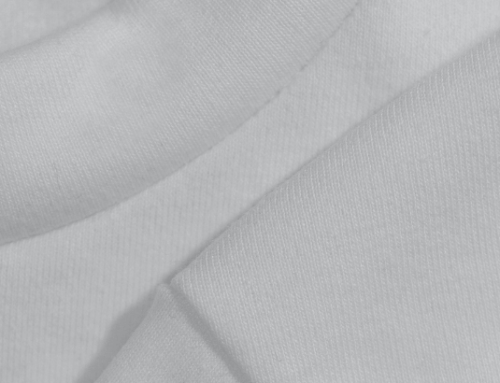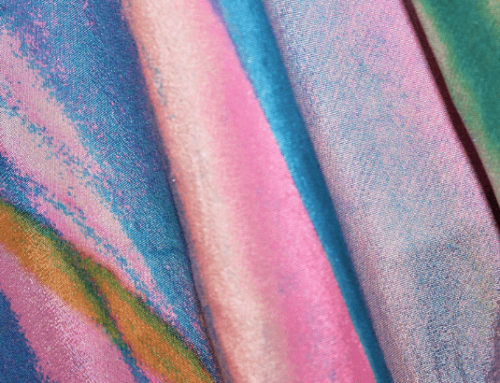As part of our ongoing series on fabrics, we’re taking a look at one of the most misunderstood and celebrated fabrics of all time: humble, versatile polyester. We’re 100% committed to sustainability in fashion, but we know that things aren’t always black and white. We’re not here to judge, just educate!

What is Polyester?
Polyester is a manufactured synthetic fiber related to plastic. On a chemical level, polyester is derived from petroleum or crude oil, chemicals, and water. This man-made fiber can be separated into a few types based on how it is created, the most common of which are PET and PCDT. PET (polyethylene terephthalate) is a stiff, durable fiber common in fabrics as well as water bottles. There is also PCDT polyester, which is more elastic and resistant to pilling. Another form of polyester that is rising in popularity is plant-based polyester; unlike traditional polyester, it is made using sugar cane instead of petroleum.
Why Do We Use Polyester?
Polyester is truly one of the most versatile fibers man has developed. We see polyester fabric used for just about every purpose from undergarments to sweatpants and swimwear, to suits, athletic apparel, and outerwear. It’s also a staple in many household fabrics such as upholstery, drapes and linens.
- It’s durable and wrinkle-resistant, so it’s perfect for suits and pants that need to look good all day.
- It’s stain-resistant, so you don’t have to worry about spills.
- It’s strong and holds up well to washing and drying.
- It’s affordable and easy to care for.
It’s also a shape-shifter: it can mimic most of the qualities of natural fabric materials at a fraction of the price, and its availability is ubiquitous in fabric markets around the world.
Types of Polyester Fabric
We’ve really evolved since the early days of “polyester double-knit”! Polyester is often associated with cheaply made fast fashion but that’s not always the case; some of the most popular and luxurious fabrics are also created from this man-made fiber. Here are some favorites:
Fleece – As a 3-season staple, polyester fleece outshines cotton fleece in several ways. While natural fleece is softer and more breathable, polyester fleece (sometimes offered as “microfleece”) is warmer and wicks away moisture, both preferred traits for athletic gear and outerwear. Our Favorite: Fleece shows off its sleek side with this custom high neck micro-fleece top by Tavrovka.
Twill – Not a fabric fiber but a style of weaving that results in a diagonal pattern, twill is made with either cotton or polyester. Both kinds of twill are commonly used to make jeans, denim jackets, and polo shirts. It feels casual and is durable. Our Favorite: Business is no longer basic with fall-ready custom twill skirt by Sumissura.
Crepe – Traditionally made of silk or wool, this thin, wrinkly, often lightweight fabric is also created using polyester. Crepe is popularly used to make women’s blouses, dresses, and skirts because has a nice drape, and can be embedded further with textures such as brocade patterns, or smoothly woven to mimic silk in crepe de chine style. Our Favorite: We love Samshek’s durable, lightweight, crepe pants with suspenders.
Velvet – Originally made from silk, today polyester is the most common fiber used to create the soft, plush material we associate with special occasion dresses, vests, and jackets. When made of polyester, the fabric may lack the shine and richness of natural velvet, but will be more durable for frequent use. Our Favorite: Nothing says velvet like the color blue and these fully customizable blue velvet pants by Sumissura.
Satin – Similar to velvet, satin was traditionally made of natural silk, but more affordable polyester satin (sometimes called manmade silk) has the same lustrous and soft feel and a nice drape. Like twill, satin fabric is a reference to the weave and not the fiber; it is created by weaving four weft yarns over a single warp yarn at a time. The flowy appearance is desirable in skirts, blouses, lingerie, and dresses. Our Favorite: Satin shows its sexy side with this black satin shirt dress by Nikcsa.
Chiffon – Chiffon is a sheer, light fabric used often in evening wear, blouses, lingerie and nightgowns. Polyester chiffon is not as soft as natural silk chiffon, but it is also much more affordable; except for luxury items, the majority of chiffon is now synthetic. Our Favorite: This pink chiffon party dress by Teyxo wears like a dream!
Is Polyester Safe?
Polyester gets a bad rap because it’s made from petroleum, which is a non-renewable resource. Plus, making polyester is a very energy-intensive process that uses a lot of water and dangerous chemicals. These chemicals pollute the environment, which is bad news for the planet.
Believe it or not, for a long time polyester was considered MORE sustainable because of its durability and the need for less water and heat during washing. However, it has since been discovered that polyester releases small amounts of microplastics each time it is washed, which contaminates our air and water and may have harmful implications.

Conclusion
Despite the drawbacks of polyester, we do not necessarily need to stop using this ubiquitous and versatile material. Balodana designers are aware of the challenges of balancing sustainability with the demands of consumers who appreciate the benefits of wearing this fabric. While some manufacturers have done their due diligence to reduce the harmful repercussions of creating and working with polyester, there are also things that we as consumers can do to negate some of the impact on our environment.
As polyester is created to be stain resistant, spot treating areas of the fabric, especially outerwear, and washing less frequently can reduce the amount of microplastics that enter our water systems. Furthermore, there are dry cleaning kits (Dryel) and steam cleaning can be used to “clean” polyester clothing without water. Moreover, avoiding fast fashion and selecting garments for durability and timelessness encourages overall sustainability and reduces the carbon footprint.
Resources
https://sewport.com/fabrics-directory/polyester-fabric
https://cfda.com/resources/materials/detail/polyester
https://www.kleiderly.com/our-blog/fabric-series-all-about-polyester
https://batikindonesia.com/different-types-of-polyester-fabric/
https://sewport.com/fabrics-directory/polyester-fabric
https://www.masterclass.com/articles/learn-about-crepe-fabric
https://www.waynearthurgallery.com/velvet-vs-polyester_fbic/#:~:text=Velvet%2C%20known%20for%20its%20plush,wrinkle%20resistance%2C%20and%20easy%20care
https://sewport.com/fabrics-directory/twill-fabric
https://sewport.com/fabrics-directory/chiffon-fabric
https://decideoutside.com/difference-between-cotton-fleece-and-polyester-fleece/


